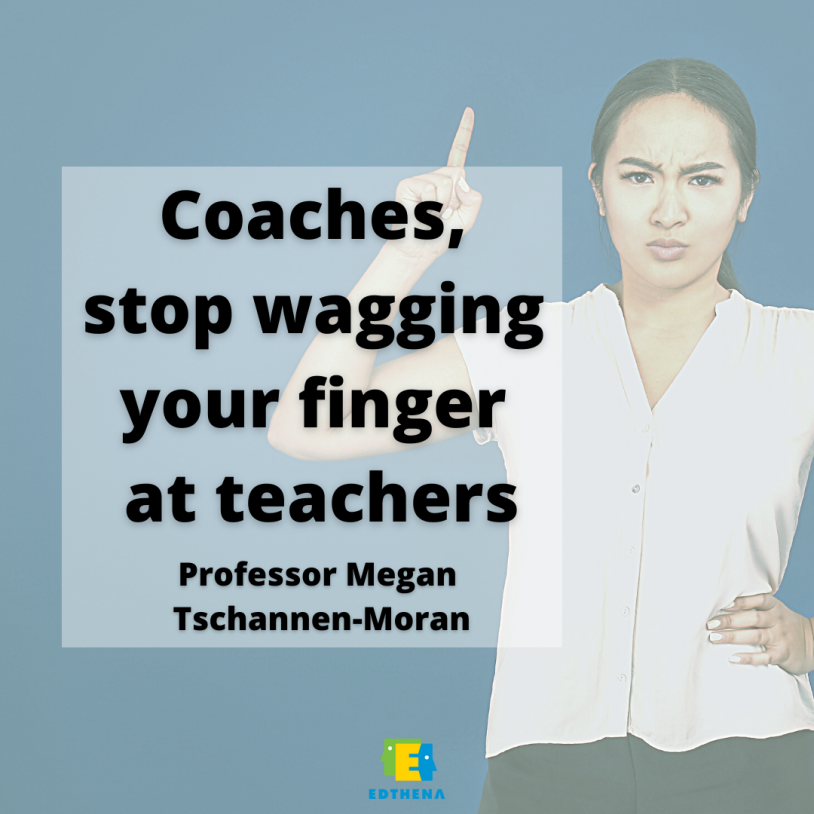Take Off That Evaluator Hat and Help Teachers Feel Safe with These 4 Coaching Best Practices
It’s tricky juggling coaching best practices when your role also calls for evaluating teachers.
Teacher support can take multiple forms and according to William & Mary School of Education’s Professor Megan Tschannen-Moran, it’s important to distinguish between coaching and evaluating.
Also the Chief Academic Officer at the Center for School Transformation, Dr. Tschannen-Moran identified four coaching best practices to ensure teachers feel safe while they are learning and growing.
Megan Tschannen-Moran shared the strategies for school leaders and instructional coaches with Edthena founder and CEO Adam Geller in this PLtogether Lounge Talk.
Watch the full interview above, or continue reading for the four coaching best practices, including keeping your support teacher-centric and checking any judgment at the door.
Do teachers know the difference between your coaching and your evaluations?
Often, the leader in charge of supporting teachers’ growth and development is also the person tasked with their evaluations. Megan Tschannen-Moran acknowledges these are both crucial functions, but notes that they are distinct.
And drawing a bright line between coaching and evaluating is a critical best practice. Coaching is about supporting and guiding teachers’ learning and growth, whereas evaluation is a formal process to rate and review their teaching.
“When we’re not clear about the distinctions, it muddies the water because they have a different emotional impact on teachers,” said Megan Tschannen-Moran.
Evaluations can cause stress and anxiety for teachers, so it’s important teachers know when they are being evaluated.
Then, leaders must be clear when that form of interaction is over and they are returning to their role of coaching.
For Megan, this can be as simple as saying, “I’m taking off my evaluator hat. Now I’m all-in on wanting to support you to be the best educator you can be.”
Coaching must be teacher-centered and strengths-based
Two other coaching best practices revolve around the approach the coach takes to supporting and guiding teacher improvement.
That coaching approach must be both teacher-centered and strengths-based to help the teacher feel safe in growing as much as possible.
“A hallmark of coaching is that we want to keep the responsibility for professional learning with the teacher,” said Megan Tschannen-Moran.
This means coaching should not be overly directive, which places responsibility back onto the coach.
Rather, teachers should feel a sense of ownership and autonomy over their own growth. This can look like ensuring teachers identify or set their own learning goals or projects.
It’s also important to have a strengths-based coaching approach. Megan Tschannen-Moran shared two important questions for coaches to keep in mind:
- What is the teacher doing well?
- What are the teacher’s strengths?
This approach is rooted in the idea that the teachers being coached are not blank slates but come with their own strengths.
“We’re not starting from unknown territory,” Megan explained. “We’re saying, ‘Here are some things that you are really good at and let’s build on those.’”
Stop wagging your finger at teachers

Another coaching best practice also aligns with the principle that teachers must feel safe in order to learn and grow.
This means that coaching must feel like a judgment-free zone, even if that’s difficult at times.
“We’re not here to wag our fingers at people,” Megan reminded coaches and leaders. “Our ultimate goal is to help them to get better.”
Making teachers feel as if they’re wrong or inadequate only leads to defensive feelings, which stunt growth.
Keeping fault and blame out of your feedback and support is key.
These coaching best practices help teachers feel safe to learn and grow
Your coaching approach should be:
- Clearly distinct from evaluations
- Teacher-centered
- Strengths-based
- Judgement-free
With Megan Tschannen-Moran’s strategies, your coaching will help teachers feel more comfortable and therefore more primed for development.
Interested in more coaching best practices? Check out our other resources for coaches or watch the rest of our interviews with Dr. Tschannen-Moran.


